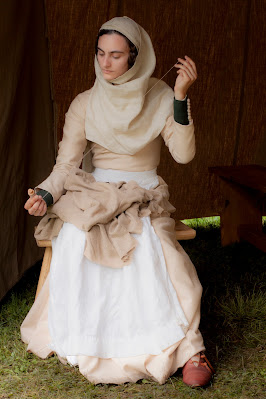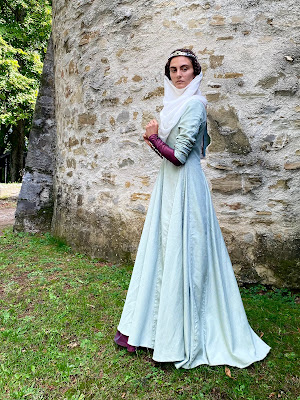Some things to consider before starting research
Some things to consider before starting research
(Whether it's for a novel, a dress or anything else related to history)
 |
My latest reconstruction (lower-middle class). Ph: @MassimilianoLocicero |
Imagine: you are at a re-enactment event and you see a person in a spectacular dress. It’s the dress, the one you've always dreamed about. It’s been a couple of years, you learned how to do research, and now you can see that your beloved dress—in which you spent hours of hand sewing work and a lot of money—is just a summary interpretation of something vaguely historical.
How to prevent all this?
 |
| My first re-enactment. Ph: @impressum |
Re-enactment is not a source. No matter how much you may trust a re-enactor, their clothing is not a historical or archaeological source and should therefore not be treated as such. Everyone can make mistakes and it's better to do it with your own head. Not counting that "stealing" other people's designs and weeks of research is awful (like *certain brands* steal designs from small artisans).
Any advice is valuable, but sources are even more. Listen to "older" re-enactors it’s not always a good idea: advice given without the support of historical and archaeological sources can turn out to be some kind of commonplaces. If you are aiming for an excellent level of historical reconstruction you shouldn't be embarrassed to ask for the sources for the advice that people gives to you. It's not about being rude: historical reconstruction has a very high cost and making a mistake can be really expensive. And if you're writing a book... just imagine to only notice the mistake after the publication.
 |
| One of my first dresses. Wrong material! Ph: @amokphoto |
Saving it's okay, but not always! "Minimum expense, maximum yield" doesn’t work for all. There are ways of saving that allow you to maintain a high level of reconstruction—such as the purchase of second hand materials—and ways of saving that can turn out to be huge flops. For example, choosing a synthetic material instead of a natural one could make us the main target of all the campfires present at the event. Or just imagine representing a noble with a really restricted budget: it could be terribly ineffective.
It takes all kinds to make a world. Just because a certain type of beard braids is used in a remote region of north-eastern Europe, this does not legitimize me to use it in reconstructions of anywhere else in the world, even if we are talking about the same period. Not considering the geographical area is as much a mistake as mixing different eras.
 |
| My latest reconstruction (noble) |
Keep your mind open. When an interpretation makes sense, it doesn't mean that there aren't ten others that make sense too. Don't get stuck on a single idea, explore and experiment different interpretations before starting the reconstruction. Don't forget that history is always a hypothesis and that your idea can be corroborated by some sources and discredited by others.
If your goal is the most accurate reconstruction possible, sometimes you will have to put aside your personal taste to immerse yourself in a lifestyle that has nothing to do with yours. And remember: reconstructing is not a race but a journey that aims at constant improvement.


Comments
Post a Comment